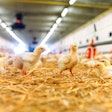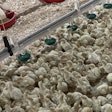
All poultry operations should have a biosecurity program in place, but those programs must meet certain criteria in order for them to be successful.
“An on-farm biosecurity program must be both effective and practical, and remember it always comes down to compliance. So you must have buy-in from everyone involved from the top level and the bottom-level up,” Danielle Botting, technical services veterinarian for Hy-Line North America, said during the Nebraska Poultry Industries Virtual Conference on February 24.
While most commercial poultry operations likely already have biosecurity programs in place to keep diseases such as highly pathogenic avian influenza and virulent Newcastle disease away, Bottig said those programs need to be re-evaluated at least on an annual basis to see if any changes need to be made.
Botting also offered five descriptions that should fit your farm’s biosecurity program in order to ensure its success. Those are:
Financially reasonable for the farm type
While it might sound good to have all sorts of biosecurity protocols and practices in place, they must make financial sense for the size of the operation, she said.
“If practices are too costly, it may not be sustainable in the long term,” said Botting.
Practical enough to assure compliance
Biosecurity programs should always be practical enough so 100% compliance is attainable, she said.
“If practices or standard operating procedures (SOPs) become too complicated, people can cut corners and will cut corners” and then the program will be ineffective, she said.
Compliant with local and national laws
Make sure that all practices are within the laws, and in compliance with standards for programs you follow, such as the National Poultry Improvement Plan (NPIP).
Have clear and specific SOPs
When you have standard operating procedures, they must be concise. They must be easy to understand in order for them to be followed by both people who work on the farm, and by visitors.
“They should be readily available when you have people entering the farm,” she said. “There should never be a question about how to do a certain procedure. It should always be as clear-cut as possible.”
Subject to regular audits
For biosecurity programs, Botting said, “It’s all about compliance, and the only way to be sure about that is an audit.”
Those audits will be essential in helping you determine the success of your program, she added.


















